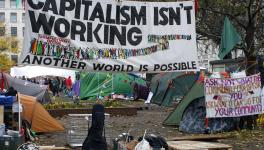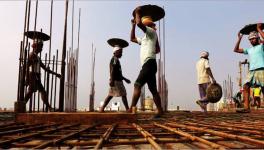First Quarter GDP Estimates This Year no Cause for Celebration
The estimates of Gross Domestic Product (GDP) for the April-June quarter released by the government on August 31 paint a dismal picture of the Indian economy. Since the GDP in real terms (at 2011-12 prices) shows an increase of 13.5% over the first quarter GDP a year ago, and since 13.5% appears an impressive figure, official spokespersons have been putting a cheerful gloss over it. But a closer look reveals an economy getting further bogged down in a state of stagnation.
The economy, it may be recalled, had contracted sharply in 2020-21 because of the pandemic and the associated lockdown that was particularly draconian in India, and the recovery in 2021-22 had been incomplete from the trough reached a year ago. The 2022-23 first quarter figures, therefore had assumed particular significance as an index of the economy’s underlying resilience, especially since the impact of COVID-19, though not altogether absent, had lessened to such an extent that 2022-23 could be taken as a “normal” post-pandemic year. And the comparison here should be not with 2021-22 or 2020-21, both of which were affected by the pandemic, but with 2019-20 which was the last “normal” pre-pandemic year.
The first quarter GDP in 2019-20 was Rs 35.85 lakh crores, and the first quarter GDP in 2022-23 has been estimated at Rs 36.85 crores, which is only 2.8% higher. The economy in short is stagnating even at a time when the pandemic has largely abated and can no longer be held responsible for it. Some official economists have expressed satisfaction that at least the GDP figure has crossed what it was in the first quarter of 2019-20; but there has been a gap of three years in between, during which the population has increased and the capital stock has expanded. Simply crossing the GDP of three years ago, therefore is no cause for celebration; on the contrary, it reflects a situation of crisis. Put differently, between the pre-pandemic “normal” and the post-pandemic “normal”, the per capita GDP has fallen, even though the per capita capital stock has expanded.
It must also be remembered that 2019-20 itself was not a great year for the Indian economy. The first quarter GDP in 2019-20 had increased by only 5% over the previous year’s first quarter, compared to 8% in the comparable period of the previous year, causing much disquiet among official economists. The stagnation that was setting in during 2019-20 has thus persisted and has even intensified now. The pandemic was an extraneous imposition upon this picture of stagnation; it muddied the picture and gave rise to the false impression that all the economic travails were because of the pandemic, that there was nothing fundamentally wrong with the underlying economy. But once this extraneous imposition is removed, we are back with the underlying stagnation, belying all the breezy official optimism. This stagnation is a matter of grave concern because even when growth brings misery to the working people, as it did in India during the heyday of the neo-liberal period, stagnation brings even greater misery.
The basic reason for this stagnation is the stagnation or decline in the purchasing power in the hands of the working people that occurs in a neoliberal economy because of growing income inequality. In this specific instance, however, the rise in private consumption expenditure between the first quarters of 2019-20 and 2022-23 has been higher than the growth rate of the GDP. True, the consumption of the working people has been languishing for want of adequate purchasing power, but the consumption of the rich and the well-to-do, which had got restricted perforce during the pandemic, has now increased suddenly; and this has pulled up the total private consumption expenditure. The immediate cause for the stagnation in GDP therefore lies elsewhere: two additional factors prevent a higher level of aggregate demand and hence a higher GDP. These are a stagnation in government consumption expenditure, and an increase in the trade deficit, i.e. in the excess of imports over exports.
While private consumption expenditure in real terms (at 2011-12 prices) increased between the first quarter of 2019-20 and that of 2022-23 from Rs 19.74 lakh crores to Rs 22.08 lakh crores, and while gross fixed capital formation increased from Rs 11.66 lakh crores to Rs 12.78 lakh crores, government consumption expenditure declined marginally from Rs 4.21 lakh crores to Rs 4.14 lakh crores. At the same time, the excess of imports over exports increased from Rs 1.62 lakh crores to Rs 2.98 lakh crores. The ratio of trade deficit to GDP (this is calculated by taking both magnitudes at current prices) increased from 4% in the first quarter of 2019-20 to 5.3% in the first quarter of 2022-23. If the same ratio of trade deficit to GDP had been obtained in the first quarter of 2022-23 as in 2019-20, then the growth rate in GDP between these two quarters would have been 4.1% and not the 2.8% that has actually occurred.
Thus the two immediate additional factors that worked to accentuate the stagnation of the economy, over and above the basic problem of growing income inequality, were: first, fiscal conservatism that kept down government consumption (i.e., non-investment) expenditure; and second, the fact that a much larger proportion of aggregate expenditure “leaked out” abroad in the form of imports. And both fiscal conservatism and unrestricted openness to imports are features of a neo-liberal regime, as is the basic problem of growing income inequality. Neoliberalism not only underlies the long-term stagnation of the economy, owing to the growing income inequality that is an immanent tendency under it; but it also underlies the additional factors that accentuate this stagnation. What is more, this stagnation will become worse in the days to come for at least two reasons.
The first has to do with the fact that investment will not be sustained at its present level if GDP continues to stagnate. Since between 2019-20 and 2022-23, there has hardly been any increase in GDP, the production capacity that existed in 2019-20 is quite adequate to produce what is being currently produced. But meanwhile, investment has continued to occur; and even if we leave out the investment that may have occurred for replacing capacity that is being retired because of age, and also the investment that embodies new processes, a certain amount of investment must have occurred that has added to capacity and that would now remain unutilised. In other words, the investment that has occurred during this period of GDP stagnation would have increased the level of unutilised capacity in the economy. Because of this growth in unutilised capacity, investment must decline in the days to come, contributing further to a lowering of aggregate demand and hence output.
The second reason has to do with the increase that is occurring in the trade deficit, which is also leading to a widening of the current account deficit. In a situation where finance is flowing away from countries in the periphery to the metropolis, meeting an increasing current account deficit becomes even more difficult, giving rise to a further depreciation of the rupee, which in turn raises the rate of inflation in the economy. The typical response to an acceleration in the rate of inflation is to cut back on government expenditure and raise the interest rate, which is exactly what will keep happening here. These are fundamentally recessionary measures whose effect is to reduce the bargaining power of the working people so that the inflationary process is resolved at their expense.
There is a further point here. When the current account deficit widens, expectations build up among the financiers that the rupee will further depreciate, which leads to an outflow of finance, so that these expectations become self-fulfilling; and the same scenario, of acceleration in inflation and recessionary measures to control such inflation, unfolds. The stagnation of the economy therefore is likely to become further accentuated.
The widening of the trade deficit at this juncture is the most ominous new development in the Indian economy. The tendency towards stagnation was already there even before the pandemic; what we then had in addition was an upsurge in inflation, globally and India as well; and now we have a widening of the trade and current account deficit on top of all this. The economy in short is getting engulfed in a crisis that is becoming ever more comprehensive, and there is no solution to it within the parameters of neoliberalism.
Get the latest reports & analysis with people's perspective on Protests, movements & deep analytical videos, discussions of the current affairs in your Telegram app. Subscribe to NewsClick's Telegram channel & get Real-Time updates on stories, as they get published on our website.























